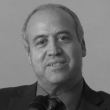
CAE Manager, Jaguar Land Rover
Dr Tayeb Zeguer hold a first honour degree in mechanical Engineering, a master degree in computer aided design and a doctor ( PhD) in optimisation and robustness. Tayeb joined Jaguar in 1984 in power train department. He worked as CAE analyst in various departments using linear and non linear codes on various components and vehicle assemblies. He specialised in multidisciplinary optimisation (MDO), safety and advanced CAE. Tayeb has proven ability to take CAE application to the next level, whether at component level , subsystem assemblies or complete vehicle. Tayeb has consistently shown leadership and vision to define a successful CAE strategy resulting in increasing accuracy, speed and robustness within JLR.
Tayeb goal now is to provide JLR with an integrated, automated and design improvements methods in the use of MDO in order to design and dramatically improve the quality of product design against parameters like performance, robustness and time to market.
Speeches
Carlo Poloni will chair the Automotive Roundtable that will see Managers and Experts from the simulation departments of the top automotive companies discuss about the strategies to be put in place for a firm management of the increasing complexity. Tayeb Zeuguer (JLR) and Michael Tormanen (Volvo) among others will bring to conference participants their views as simulation specialists and explore best practices, future trends and opportunities.
Competition and customer demand are constantly pushing automotive manufacturers to launch new models at shorter intervals while satisfying the ever increasing demands in performance, environmental impact and costs. In order to remain competitive, an automotive OEM must cope by applying continuous pressure to reduce cost and improve design while reducing deployment time.
Higher fidelity CAE models have allowed the shift towards zero prototyping, thus significantly compressing the design cycle. However, in order to run CAE assessments on any design changes, the current process requires the generation of CAD data from the designers. This in turn must be processed into CAE data (clean, mid-surfaced FE mesh) which are then assembled into the various subsystem/vehicle analyses. This multistage process of design into CAE analysis is a long lead time process and restricts the running of optimisations up-front. Ideally, the design and CAE validation should go hand in hand – almost bypassing the CAD phase. As no mature CAD data is available, it must be possible to directly alter existing models and enable analysis of simple geometry changes.
This upfront simulation is the key driving force for a paradigm shift in product development and, though the MDO is integrated in the development cycle at JLR, it must now be allowed to drive geometry changes. It therefore needs to be aware of the manufacturing and cost implications of any changes proposed. Without this check, the process would constantly present theoretical geometries – impractical, difficult or costly to manufacture. This paper describes how it is possible to use an MDO for upfront simulation and showcase a process that could lead to a truly CAE driven design.


